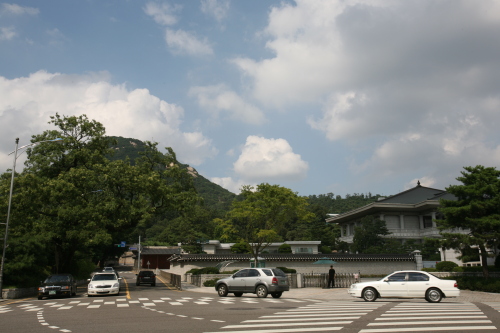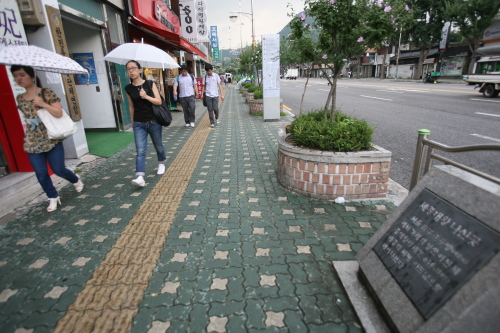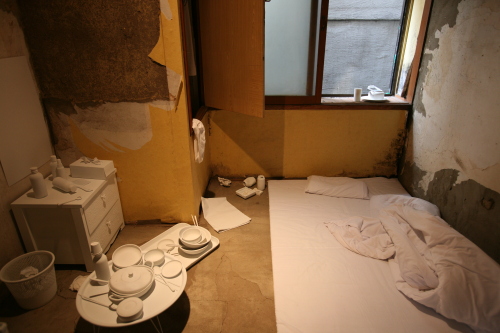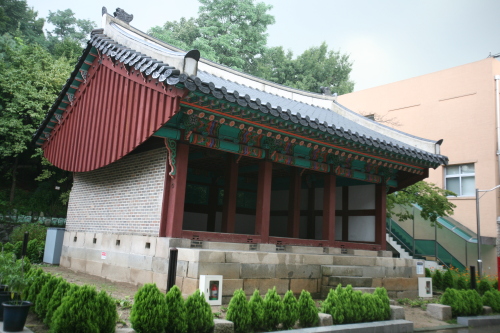[Rediscover Seoul(94)] Explore the hidden attractions of Seochon
ByPublished : Sept. 9, 2010 - 19:39
You may have heard of Bukchon, but how about Seochon? During the Joseon Dynasty the town located near the gate to the west of Gyeongbok palace was called Seochon, literally meaning “west village.”

King Sejong was born in Seochon, and King Yeongjo lived there before he became the king. Most of the residents of Seochon were professionals such as interpreters or doctors. In the modern era, Seochon was the home to writers and artists, including Jeong Seon, Kim Jeong-hui and Lee Jung-seob. Seochon’s spider-web of alleys is filled with history and culture.

The alleys of Tongui-dong and Hyoja-dong
The historic value of Seochon was recently recognized by the city. Seoul Metropolitan City announced a plan to conserve 663 hanok buildings in Seochon and Jongno-gu and made a list of the 20 best alleys for walking.
If you want to explore Seochon, be prepared to negotiate a maze of alleyways. When you make a turn at the end of one, you are faced with many neighborhoods, including Tongui-dong, Changseong-dong and Hyoja-dong. This must be the reason why the area was known during the Joseon Dynasty as Wihang (委巷), a town with narrow and winding paths and small houses.
Leave Gyeongbokgung Station from Exit 4 and walk along Tongui-dong alley until you get to the lacebark pine tree site. The tree, with a height of 16 m and a girth of 5m, was designated as a natural monument in 1962, for its size and beauty. However, it was flattened by a huge typhoon in July, 1990. Only the stump of the original tree remains.
Changuigung -- the house in which King Yeongjo stayed before he was enthroned -- is also in this neighbor hood. Changuigung was closed when the Oriental Development Company was established in 1908. After the liberation in 1945, the house was given to the government.
Princess Hwasun, the daughter of King Yeongjo is the great-grandmother of Joseon scholar Kim Jeong-hui, also known as Chusa, who lived in the area. This family connection gives an indication why Chusa’s house was so close to Changuigung.
Let us walk out to the main street of Hyojaro and move toward Cheong Wa Dae. Right in front of the gate, Yeongchumun, is an inn called Boan Yeogwan. A lot of famous writers and artists used to stay there. In 1936, 22-year-old, Seo Jeong-ju, a famous poet, stayed at this inn, and published a literary magazine, “Siinburak” with poets Kim Dong-ri, O Jang-hwan and Kim Dal-jin.
At the time, many young artists, including poets and writers, stayed at the inn long-term before making their debut as writers. During the military dictatorship, most customers of the inn were staff of Cheong Wa Dae and family members who came to meet the staff. The inn operated for 80 years, but closed in 2006 as it faced demolition. It was later kept and revived as a cultural site.
As you enter, you find the inner parts of the building have remained as they were including small rooms, clay walls, squeaking wooden stairs, and common bathrooms. Artwork is exhibited in this space.

From Boan Yeogwan, turn toward Cheong Wa Dae. You will find various cultural spaces here, including galleries and book cafes. Then, you’ll find the Presidential Committee on Social Cohesion and Cheong Wa Dae Sarangchae. From here, you get a complete view of Cheongwadae.
Shin Ik-hi’s house is located nearby. Shin Ik-hi was the founder of Kookmin University, and it is thought that the old school building was located there.
At the alley in front of Shin Ik-hi’s house, there is a stone sign to show where the twin red gates of Ssanghongmun stood.
Ssanghongmun was a couple of red gates the king bestowed to pay tribute to the dovotion of two men to their parents. They sacrificed their lives to save their mother. “Dongguk Yeojibigo” recorded that the street in front of the Cho’s house was called “Ssanghyoja Geori,” or “two devoted sons’ street” because of the actions of the Cho brothers, which is the origin of the name Hyoja-dong today.
Traces of history in Cheongun-dong
Continuing through Hyoja-dong, the road leads to Cheongun-dong. Cheong Wa Dae and Chilgung are both located here. With an Internet reservation, you can visit these two places. There is Gyeongbokgo, where Jeong Seon was born in 1761. Across the street is Cheongun Elementary School.

Statesman and poet Jeong Cheol (1536-1593) was born near the school and spent his childhood there. To let people know that Jeong Cheol used to live in Cheongun-dong, a stone sign with an engraving of his work was erected beside the main street near the elementary school. If we take the alley over the school, we meet the site of Kim Sang-yong’s house. Kim Sang-yong had built a house called Neumyeondang (凜然堂) and Song Si-yeol (1607~1689) engraved a phrase, “Daemyeongilwol Baeksecheongpung(大明日月 百世淸風)”, on the rock face next to Neumyeondang. Over the years the first four letters have worn away, leaving only the last four.
If we move back and turn toward the Seoul National School for the Deaf, we come to Seonhuigung. This is where the ancestral tablet of Yeongbin, the mother of Crown Prince Sado and a concubine of King Yeongjo, is enshrined. It was built in 1764, during of King Yeongjo’s reign. It was originally named Uiyeolmyo, after the posthumous epithet of Yeongbin, but was renamed as Seonhuigung in 1788.
Next, let’s cross the street to see the Woodang Memorial. The memorial was established to pay tribute to the life and spirit of patriot Lee Hoe-yeong. Woodang is the descendent of Lee Hang-bok and the younger brother of Lee Si-hyeong, the first vice president of Korea.
Hidden treasures of Wihang,
As we walk along the street, and go over the hill, Tongin market appears. If we take the road toward Tongin-dong, there is a stone sign to mark Junsubang, the birthplace of King Sejong. Junsubang was the name of the house where King Taejong lived until he was enthroned, in 1397, the 6th year of King Taejo’s reign. The house was positioned in a very good location in terms of feng shui, with a mountain in the back and a stream in front.

Near Junsubang, the poet Lee Sang (1910-1937) lived from 1912 to 1932 at 154 Tongin-dong. His uncle, who was very rich and lived in a large house, adopted him. His work entitled “Old Castle Inherited from Great-Great Grandfather” is about this house. When his uncle died in 1932, the cousin of Lee Sang inherited it. The next year, his cousin sold the house to a constructor. He opened a tea house, Jebi Dabang -- Swallow Tea House -- with Geumhong in June 1933, However, he later wandered from place to place, and died very lonely in Tokyo in 1937. There is no sign found in front of the site of Lee Sang’s old house. A bookstore has been located near the house there for a long time now and attracts many visitors who want to witness the changes over time, reflected here.
Now, if we take the opposite route to cross the market, the sign to mark the original site of Songseogwon appears at the street corner of Ogin-dong. This place was named by Cheon Su-gyeong, a commoner poet who lived during King Jeongjo’s reign. Near the site of Songseogwon, the uncle of Queen Sunjong, Yun Deok-yeong’s luxury mansion was located. The house was so huge and extravagant it was called “Qin Shi Huang’s Palace of Joseon.” This “palace” was used as the headquarters of the United Nations Commission for the Unification and Rehabilitation of Korea, but was destroyed by fire in 1966. However, the Park Nosu’s house, built in 1938 remains. Yun Deok-yeong had built it for his daughter. The prominent design of this two-story house is hanok, but a western style is evident in some parts of the house.
From Park Nosu’s house, if you walk toward the mountain, you will be led to the Ogin Sibeom Apartment. There are small bridges hidden in the midst of noisy reconstruction work, where you can imagine the site of Prince Anpyeong’s House.
Then, the maze starts again around Nusang-dong and Nuha-dong. This area is the representative area of Wihang and is home to the house of painter Lee Jung-seob (1915-1956). It is a Japanese-style house where he stayed for up to five months in 1955 when he was preparing for his private exhibition.
At nine Nusang-dong, there is the house of female poet, No Cheon-myeong and the board house of Yun Dong-ju (1917-1945). On this site, there is a three-story building. At 181 Nuha-dong, a little away from Nusang-dong, there lived Cheongjeon Lee Sang-beom (1897-1972), an Oriental painter. He made it his home for 34 years, until he passed away.
Next destination is Pirundae. You can follow Pirundae 1-gil toward Paiwha Girls’ High School. The Students’ Hall of Paiwha Girls’ High School (built in 1916), which has the characteristics of early 20th century Western-style construction, was originally used as lodgings for missionaries.
Pirundae is located in a secluded spot in the school. Pirundae is the site of Lee Hang-bok’s (1556-1618) House. Lee Hang-bok was known as a competent prime minister during the Joseon Dynasty. They say that you could see all of Seoul including Gyeongbokgung and the mountains from the Pirundae rock, but all you see now are buildings.
Transportation
Public Transportation: Line 3 Gyeongbokgung Station, Exit 4, will lead you to Tongui-dong while Exit 2 leads to Jahamunno. Exit 1 leads toward Paiwha Girls’ High School and Sajik-dong.
Restaurants: Donggungsanchae (02-722-2234, Bibimbap) and Tosokchon (02-737-7444, Samgyetang) are famous restaurants in Tongui-dong. In Sajik-dong, Rooking Razzing Cakery (02-734-7323, coffee and cake), Olgaengigukjib (02-722-5324, home-style meals) are nice. In each and every corner of the alleys you can find unique fusion cafes.
Information: Cheongwadae Saranchae (02-723-0300, www.cwdsarangchae.kr/). To make reservations for Cheong Wa Dae email tour@president.go.kr or for more information visit english.president.go.kr/main.php.
Tour programs provided by Seoul Tourism Organization are available upon request. For more information: 02~6925~0777.
By Lee, Sin-hwa (Author of “On the Camino,” www.sinhwada.com)







![[KH Explains] Hyundai's full hybrid edge to pay off amid slow transition to pure EVs](http://res.heraldm.com/phpwas/restmb_idxmake.php?idx=644&simg=/content/image/2024/04/18/20240418050645_0.jpg&u=20240419100350)






![[From the Scene] Monks, Buddhists hail return of remains of Buddhas](http://res.heraldm.com/phpwas/restmb_idxmake.php?idx=652&simg=/content/image/2024/04/19/20240419050617_0.jpg&u=20240419175937)

![[KH Explains] Hyundai's full hybrid edge to pay off amid slow transition to pure EVs](http://res.heraldm.com/phpwas/restmb_idxmake.php?idx=652&simg=/content/image/2024/04/18/20240418050645_0.jpg&u=20240419100350)

![[Today’s K-pop] Illit drops debut single remix](http://res.heraldm.com/phpwas/restmb_idxmake.php?idx=642&simg=/content/image/2024/04/19/20240419050612_0.jpg&u=)